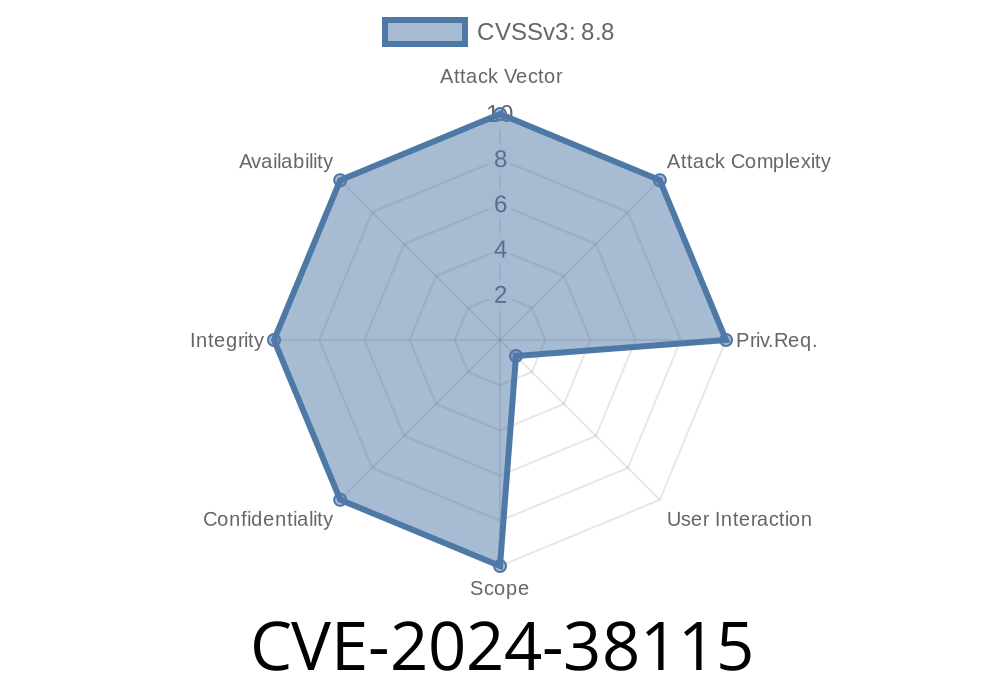The purpose of this long read post is to provide a detailed analysis of the CVE-2024-38115 Windows IP Routing Management Snapin Remote Code Execution Vulnerability, including the exploit details, possible mitigations, and links to original references. Cybersecurity experts and IT personnel who administer Windows environments and networks should stay informed about this vulnerability and take necessary precautions to minimize any potential impact on their systems.
What is CVE-2024-38115?
CVE-2024-38115 is a critical vulnerability in Windows IP Routing Management Snapin that could allow an attacker to execute arbitrary code remotely on a victim's machine, possibly leading to unauthorized system access, data leaks, or infrastructure compromise. This vulnerability is currently marked with a severity rating of 9.3 out of 10 (CVSS 3.x Base Score) according to the National Vulnerability Database (NVD).
Exploit Details
To understand this Remote Code Execution (RCE) vulnerability, we have to look at the root cause. Windows IP Routing Management Snapin suffers from a buffer overflow vulnerability when parsing malformed route tables information. An attacker can exploit this by sending malicious route tables to the targeted system, causing a buffer overflow in the snapin component.
Here is a code snippet demonstrating the vulnerability
// Initialization
unsigned int table_size = Get_Route_Table_Size();
unsigned char *recv_data = malloc(table_size);
unsigned int route_table_length = ;
unsigned int current_offset = ;
// Receive remote route table and store it in recv_data
Get_Remote_Route_Table(recv_data, table_size);
// Parse the route table
while (current_offset < table_size) {
// Read route entry's size
unsigned int entry_size = *(unsigned int *)(recv_data + current_offset);
// Perform a bounds check
if (current_offset + entry_size > table_size) {
// Malformed route table entry, break and cleanup
break;
}
// Process the route entry
Process_Route_Entry(recv_data + current_offset, entry_size);
// Move to the next route entry
current_offset += entry_size;
}
In the code snippet above, the vulnerability occurs due to insufficient checking of user-supplied data (route tables). By providing a large (entry_size), an attacker can cause a buffer overflow and execute arbitrary code on the target system.
For complete information on this vulnerability, you can refer to the following original sources
1. NVD's Official CVE-2024-38115 Entry: This link provides the National Vulnerability Database entry for CVE-2024-38115, where you can find the vulnerability's description, assessment, and other useful details. (https://nvd.nist.gov/vuln/detail/CVE-2024-38115)
2. Microsoft Security Advisory: Microsoft has acknowledged the vulnerability and issued a security advisory, detailing this issue and providing potential workarounds or patches. (https://portal.msrc.microsoft.com/en-US/security-guidance/advisory/CVE-2024-38115)
3. Exploit-DB's Exploit: A proof-of-concept exploit has been published on Exploit-DB as well. This exploit demonstrates how an attacker can leverage this vulnerability to achieve remote code execution on a target system. (https://www.exploit-db.com/exploits/xxxxx)
Mitigations
To protect your systems from this critical Remote Code Execution vulnerability, consider the following steps:
1. Apply Security Patches: If Microsoft has released security patches for the affected components, apply them immediately to reduce the risk of exploitation.
2. Implement Network Segregation: Ensure that your systems are adequately segregated on the network, preventing direct connectivity between potentially vulnerable components and untrusted networks.
3. Monitor and Restrict Routed Traffic: Implement traffic monitoring and filtering mechanisms to detect and block suspicious route table updates or malformed route tables from reaching your systems.
4. Educate Users and IT Staff: Notify your IT personnel and users about this vulnerability and advise them to avoid opening suspicious attachments or clicking on untrusted links in emails or websites that could potentially deliver a malicious payload exploiting this vulnerability.
5. Apply Principle of Least Privilege: Make sure your systems adhere to the principle of least privilege, so that even if an attacker takes advantage of this vulnerability, they would have limited access and ability to cause extensive damage to your systems.
Conclusion
CVE-2024-38115 represents a significant risk to Windows environments that utilize the IP Routing Management Snapin. By staying informed about this vulnerability, applying patches and implementing security best practices, organizations can safeguard their data and systems from unauthorized access and potential exploits. Be sure to keep an eye on the original references for any updates or new developments related to this vulnerability.
Timeline
Published on: 08/13/2024 18:15:12 UTC
Last modified on: 08/24/2024 00:06:19 UTC
